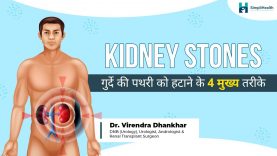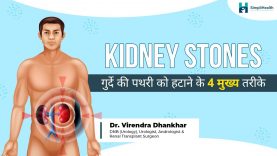Dr. Virendra Dhankhar
Dr. Virendra Dhankhar
PCNL Treatment for Kidney Stones
Dr. Virendra Dhankhar is a senior consultant urologist, andrologist, and transplant surgeon in Chandigarh. In this video, he will talk about PCNL treatment for kidney stones.
PCNL
PCNL is a modality to treat kidney stones. PCNL stands for Percutaneous nephrolithotomy.
What do we do in PCNL?
In PCNL we make an incision on the patient’s back, we reach the stone in the kidney through that incision, turn the stone into powder and suck it out through that pipe, by lithotripsy. The PCNL telescope with growing technology has become smaller in size. As a result, the track size has also gotten smaller.
This modality can remove a stone of any size. The hardness and location of the stone do not matter, PCNL can remove it. The stone clearance, the chances of the entire stone being removed compared to lithotripsy or RIRS is high. So the stone can be completely removed from any location in the kidney.
Disadvantage of PCNL
- Bleeding: The disadvantage of PCNL is that a cut is to be made in the kidney. And as the kidney is a vascular organ there are chances of bleeding. One out of hundred people may suffer from this. But this can be treated by performing some additional procedures.
- Infection: There are chances of the kidney getting infected. As the stone always has bacteria on it, and when we break the stone, these bacteria can go into the body and cause infections.
- Organ damage: The third disadvantage is that it can damage the neighboring organs, like the liver or spleen. There are 1-0.5% chances of this happening. In some people the kidney is a little higher than usual, so we have to go through the rib cage. So there is a chance of blood or water accumulating in the eleventh rib pleura lining in the lungs.
So to avoid all these complications the technology has made a few advancements. One of these is making the size of the telescope smaller. And PCNL is a part of these technological advancements.
What do we do in PCNL?
In a standard PCNL, we make a 20 to 30 french hole in the kidney. This is a standard nephroscope that is of 20 french. This is a 24 french implance sheet. We put the telescope through this and remove the stone. Now that the telescope has become even smaller, the techniques have evolved as well.
There are: Mini PCNL, Ultra mini PCNL, Micro PCNL
The process is the same but the names differ due to the size difference.
- Mini PCNL: In mini PCNL the size of the track is 16-20 french. This is the telescope used for micro PCNL. which is very small compared to this. And the track through which we put the telescope and take the stone out by the whirlpool effect. So this is mini PCNL.
- Ultra-mini PCNL: The size used for ultra-mini PCNL is 11-13 french implance sheets.
- Micro PCNL: In micro PCNL we use a 4.8 to 6 french sized sheet. This is a telescope used for micro PCNL. Besides being flexible it has very good picture quality. The track size used is 4.8 to 6 french. It has different channels, one is for irrigation and the other for laser. This is how kidney stone surgery is done.
Advantages of PCNL
What was the need for these advancements? It is because the lesser the size, the less is the chance for any complication. Less bleeding, fewer chances of organ damage. So by reducing the track size, the recovery would be faster, the pain would be less, the patient would be discharged sooner. So these are the advantages of Mini, Ultra-mini, or Micro PCNL.
If the stone is bigger than 2.5cm then PCNL is the best option. If the stone is smaller than 2.5 cm then ultra mini or mini PCNL can be done. If the stone is 1 cm, and cannot be revived by RIRS or any additional procedure is needed then Micro PCNL can be used. So this combination of procedures is an advantage for the patient.
Nutshell
PCNL is a keyhole surgery that ruled out open-end surgery. It helps us tackle any type or size of stone irrespective of the location. The advantage is that it gives complete clearance. And there are a few disadvantages due to technological advancement: instruments are very small, track size is small and the complication is low.















Comments (0)